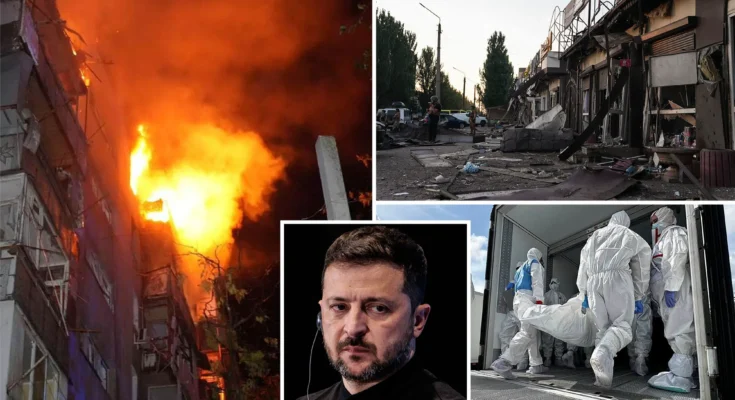DOBROPILLIA, DONETSK OBLAST — A deadly airstrike by Russian forces has devastated the eastern Ukrainian town of Dobropillia, leaving two people dead and at least 27 injured, in one of the most brazen attacks on a civilian area this month.
The bombing, which took place on July 16, struck a bustling shopping centre and nearby market in the early afternoon—when both locations were crowded with shoppers, vendors, and families. According to local officials and emergency responders, the strike was carried out using a 500-kilogram Russian glide bomb, a weapon known for its high precision and catastrophic impact radius.
A Scene of Chaos and Ruin
Witnesses reported a deafening explosion, followed by thick smoke, fire, and falling debris. Glass and metal were hurled across blocks. Rescuers described a scene of “utter devastation”—with burning buildings, collapsed structures, and people screaming for help.
“It was like the ground opened up beneath us,” said a 43-year-old vendor, hiding under a fruit stall when the blast hit. “I saw bodies, blood, and children crying. This wasn’t a military target. This was where people came to buy bread and vegetables.”
Ukrainian authorities confirmed that 54 market stalls and stores were destroyed or badly damaged. Thirteen buildings, including eight apartment blocks, were affected, displacing dozens of families. Eight cars were also blown apart by the force of the explosion.
Human Toll: A Grim Pattern
The victims included shopkeepers, elderly residents, and at least one child, according to local hospital staff. Medics struggled to handle the rush of trauma cases, many with severe shrapnel wounds and burns.
“We are treating people with collapsed lungs, internal bleeding, and traumatic amputations,” said Dr. Olena Borysenko, the head surgeon at Dobropillia General Hospital. “We had no warning. This was a targeted attack on civilians.”
This is not the first time Dobropillia has come under fire. In March 2025, the town was bombed during another Russian air campaign, killing 11 people, including five children. Residents have described a growing sense of dread and helplessness.
Government Condemnation and International Outcry
In a televised address, Ukrainian President Volodymyr Zelensky condemned the bombing as a deliberate act of terrorism:
“This is not war—it is slaughter,” he said. “This was a shopping market, a place for mothers and children. There was no military purpose. Only pain, only terror. This is the face of Russia’s war.”
Vadym Filashkin, governor of the Donetsk region, echoed that sentiment, calling the attack “another chapter in the Russian campaign of genocide.” He emphasized that the market had “no military infrastructure, no strategic value—just innocent lives going about their day.”
Global leaders have begun reacting. The European Union, UN, and NATO officials condemned the strike, calling for renewed sanctions and more defensive aid to Ukraine. U.S. President Donald Trump, who recently issued a peace ultimatum to Russia, referred to the strike as “barbaric” and reaffirmed his administration’s intent to deliver advanced air defense systems to Ukraine within weeks.
Broader Military Context: Escalation Across the East
The Dobropillia bombing came amid a wider Russian aerial offensive, targeting multiple eastern and southern Ukrainian cities with missile and drone attacks. The cities of Kharkiv, Pavlohrad, Odesa, and Sumy all came under fire this week, in what appears to be a renewed effort to terrorize civilian infrastructure.
In Pavlohrad, a wave of Iranian-made Shahed drones and hypersonic missiles hit residential neighborhoods in the early hours of July 17, killing at least eight people and injuring dozens. The coordinated nature of these attacks suggests strategic intent from the Kremlin to wear down Ukrainian morale and pressure Kyiv into concessions.
The Aftermath: Lives Shattered
Back in Dobropillia, rescue workers continued to comb through the wreckage on Thursday, fearing that more bodies could be trapped beneath debris.
Humanitarian agencies and volunteers rushed in to provide emergency food, blankets, and shelter to those displaced. One tent, set up outside a destroyed bakery, served tea and bread to weeping residents.
“We don’t know where to go. Our apartment is gone,” said Larysa, a 67-year-old widow, holding her grandson’s hand. “But we’ll never kneel to Putin. Never.”
A Question of Accountability
Ukrainian officials have vowed to gather evidence for war crimes investigations, and international legal experts are already analyzing drone footage and satellite images of the impact site.
The United Nations Human Rights Office (OHCHR) has issued a statement saying it is “gravely concerned” and will dispatch observers to document the incident.
“This fits a disturbing pattern of indiscriminate attacks on civilian areas,” the OHCHR said. “Such actions, if verified, may constitute violations of international humanitarian law and the laws of war.”
Conclusion: A War with No Borders, No Rules
As Ukraine marks another painful day in its long resistance, the bombing of Dobropillia highlights the ever-growing cost of Russia’s campaign: not just buildings lost—but lives, families, and a sense of safety erased in a single blast.
And yet, amid the horror, the resilience of the people remains.
“We are wounded, but not broken,” said Mayor Dmytro Lysachenko, standing near the charred remains of a toy shop. “The world must see this. The world must act.”
Key Statistics:
- Date of attack: 16 July 2025
- Location: Dobropillia, Donetsk Oblast, Ukraine
- Fatalities: 2 confirmed (possibly 3–4)
- Injuries: 27
- Target: Shopping centre, open-air market
- Weapon: Russian 500-kg glide bomb
- Buildings damaged: 54 shops, 13 buildings, 8 apartment blocks



